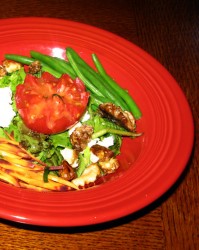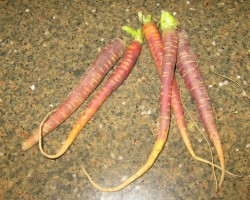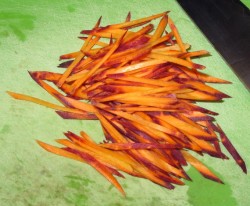Meatless Monday: Summer Salade Composee
Salade composee translates into English as “Composed Salad,” which makes vegetables sound like musical notes or something; Translations aside, what it really means is that you make or compose a salad out of many different ingredients, some cooked, some raw, which showcase different flavors, colors and textures. All of the ingredients are cut in shapes which enhance their flavors, and each ingredient is tossed in the vinaigrette dressing separately, allowing the cook to marinate each ingredient for as long or as short a time period as needed to create the flavor and texture profile desired by the cook.
Summer is the perfect time to make a salade composee, but truly, you can make one in the spring, fall or winter as well. You just need to collect an array of seasonal vegetables, fruits, nuts and salad greens, and if you like, cheese and meat, and prepare them as you wish in order to get the flavors and textures you wish to present to your guests. Then, make a vinaigrette that will enhance the flavors of the different components of the salad, and toss each ingredient separately in it, then, right before serving, place the ingredients on the plate or in the bowl in an artful, pleasing fashion that shows the different colors and shapes of the ingredients to the greatest advantage.
A salade composee can be a first course, as this one was, or it can be an entire meal. It can be light or hearty, all depending on what ingredients you choose to combine.
This salad is made of tender mixed leaf lettuces, a sweet, yet tangy Rose de Berne tomato, finely julienned purple and orange carrots, dear, tender little haricot vert (thin French green beans) blanched in broth and garlic, sugar-glazed English walnuts, and fresh chevre. I tossed everything separately with a honey-Dijon tarragon vinaigrette, some ingredients just before serving, and some an hour before dinner.
You could use plain old orange carrots in this salad, but the purple ones look so pretty when cut into thin julienne bits–orange sticks with burgundy-purple tips. Carrots are sweet and very crunchy, so I cut them very thin and very small in order to make them more delicate in flavor, as well as to show off the coloration to greatest effect. You see, in this variety of purple carrots, the purple is only apparent in the skin and in the flesh just below it, so when you peel the carrots, do so very gently and lightly, so as to remove only the skin, without taking a large layer of flesh beneath it, thus preserving the purple coloration. Then, in order to do a very fine julienne, cut the carrot into thin, diagonal slices, then stack two to four slices up, and cut those into thin sticks.
You could blanch the carrots if you wanted them to have a more softened, velvety texture, but I wanted them to retain their crisp nature. I tossed the carrots with the dressing right before serving the salad so the carrot flavor shone through.
On the other hand, the haricot vert needed to be blanched. In order to give them a bit of a flavor boost, I simmered garlic in about a cup and a half of vegetable stock until it softened and then tossed in the beans which had been topped and tailed (they have very little in the way of strings, so you just need to slice or pluck the stem end and the string end off of the beans) and left at their original length. After the beans simmered for about three minutes, they had softened to a slight velvety texture on the skin while retaining crunch on the interior. They also had a light garlic flavor. Then, I cooled them quickly in a bowl of ice, and then tossed them in the vinaigrette as soon as they were cool, so they could soak up plenty of the dressing’s tang which enhanced the very green flavor inherent to the beans themselves.
The tomatoes I cut into lotus blossoms. This looks complicated, but it really isn’t. I didn’t have anyone in the kitchen to photograph the process, so hopefully I can describe it adequately. You take a whole, clean, dry tomato, and if you wish, you can core it first. Rose de Berne tomatoes have small cores, so I didn’t bother with it. Then, with a very sharp, pointed paring knife, you plunge the point into the tomato at an angle (it should look like this: / ) along the equator of the fruit. The knife should sink to about the center of the tomato–and no farther. Pull it out and then make another cut against the first cut, also at an angle, and at the same depth, but like this, instead: \ . The two should meet in the middle and make an upside down “V” shape. You continue in this way, connecting all of the cuts all around the middle of the tomato until you have made a series of cuts that look like this: WWWWWWWWWWWWW.
Then, you grasp the tomato at the top and bottom and gently pull it apart twisting it slightly to the left or right as you go.
And voila–you have two lovely lotus blossoms. (I guess I should do a post in the future showing this with photographs, huh?)
You can do it with any size or shape of tomato–cherry tomatoes done this way make a beautiful garnish for any dish.
I marinated the tomatoes for about a half hour in the vinaigrette so they would take on plenty of its delicious flavor.
Now, for the walnuts. Sugaring nuts is a great way to give them added texture, flavor and color, but it is a bit tricky.
Start with about a cup of untoasted walnut pieces, and place them in a heavy-bottomed non-stick frying pan. Heat them up on medium heat, shaking them until they begin to toast–they will start darkening on the edges and the scent of walnut will start wafting through the air.
Sprinkle about 2/3 cup of white sugar over the walnuts and shake the pan to get the sugar to sift down evenly over the nuts to the bottom of the pan. Using a spatula or spoon that are safe for a non-stick pan and stir the nuts and sugar together. The sugar will start to melt and darken–and can start burning easily. Regulate the heat by picking up the pan and pulling it away from the heat–if the sugar starts to darken too much, take it off the heat, shake and stir vigorously to cool everything down a bit. Then, put t back on the heat a bit to get the sugar melting again. Cook, stirring, shaking and moving on and off the heat, until the nuts are coated with a shiny coat of caramelized sugar. (You can use more sugar if you want, but no less than 2/3 cup–less than that and the coating won’t be as regular.
Scrape the nuts out of the pan onto a silpat lined counter, baking pan or plate, or if you have no silpats, use a sheet of parchment paper. Allow the nuts to cool briefly, until you can touch them with your fingertips, and separate them so they aren’t stuck together in clumps. (Or, you can use two forks to pull them apart and save your fingertips from burns.) The nuts are great in salads, but they also make great snacks, coatings for cheese spreads or canapes, and fillings for dates or sweetmeats.
I tossed the nuts in the dressing just before serving so that the crisp sugar coating stayed crispy.
The lettuce leaves were tossed just before service, too–I didn’t want them to wilt.
And the cheese was tossed about ten minutes before serving so that it got some of the taste of the dressing, but not an overwhelming amount–I still wanted the tangy natural flavor of the cheese to stand out.
And then, I put it all together as you can see in the photograph above.
Use whatever you like in your salade composee–raw pears, roasted beets and toasted almonds would be great together with bleu cheese and lightly bitter greens like endive mixed with some sweeter lettuces. Sauteed summer squashes mixed with raw tomatoes, halved kalamata olives and raw sweet red peppers would also be delicious, especially with some crisp romaine and some shredded Parmesan cheese and maybe some toasted pine nuts.
The possibilities are endless.
Here is the recipe I used for my Honey-Dijon Vinaigrette with Tarragon–it would go well with the first alternate combination I mentioned above. For the second one with the summer squashes, I would use a balsamic vinaigrette with basil–substitute balsamic for the cider vinegar, use about a quarter teaspoon of anchovy paste instead of the mustard–or, leave them both out, add a tiny quarter teaspoon of tomato paste, and about three tablespoons of fresh, minced basil leaves. You could add a tiny bit of minced fresh garlic to it as well.
Honey-Dijon Vinaigrette With Tarragon
Ingredients:
1/4 cup apple cider vinegar (I used some homemade cider vinegar from a farmer here in Athens–it was light and delicious–better than the usual stuff from the grocery store!)
3/4 cup extra virgin olive oil
1 1/2 teaspoons Dijon mustard
2 teaspoons honey
2 tablespoons minced fresh tarragon leaves
salt and pepper to taste
Method:
I’m lazy. I don’t whisk my vinaigrette. I put everything except the salt and pepper into a clean jar that will hold it all, and screw the lid on and then shake vigorously. It’s easier on my wrists this way. Then, I open the jar, taste the dressing and add salt and freshly ground pepper to taste and then close it up, give it another good shake and voila! Vinaigrette!
It will keep nicely in the fridge for about a week if you have any left over.
No Comments yet
RSS feed for comments on this post.
Sorry, the comment form is closed at this time.
Powered by WordPress. Graphics by Zak Kramer.
Design update by Daniel Trout.
Entries and comments feeds.





